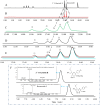Diversity and epimedium biotransformation potential of cultivable endophytic fungi associated with Epimedium brevicornum Maxim in the Qinling Mountains, China
- PMID: 40181301
- PMCID: PMC11966834
- DOI: 10.1186/s12934-025-02698-w
Diversity and epimedium biotransformation potential of cultivable endophytic fungi associated with Epimedium brevicornum Maxim in the Qinling Mountains, China
Abstract
Background: The use of biocatalysis technology to manufacture rare natural products can solve the contradiction between the market demand for rare natural products in large health industry fields and the protection and sustainable development of wildlife resources. However, the currently available research on fungal endophytes, which are great potential resources for glycoside hydrolase biocatalysts, is still insufficient. In this study, endophytic fungi from Epimedium brevicornum Maxim. were isolated in the Qinling Mountains, identified and tested for their potential to biotransform epimedium extracts into minor epimedium flavonoids.
Results: A total of 84 representative morphotype strains were isolated and identified via ITS rDNA sequence analyses and were grouped into 32 taxa. The Shannon‒Wiener index (H', 3.089) indicated that E. brevicornum Maxim. harboured abundant fungal resources. Ten strains showed strong β-glucosidase activity and exhibited the ability to biotransform major epimedium flavonoids into deglycosylated minor epimedium flavonoids, such as baohuoside I and icaritin, via various glycoside-hydrolysing pathways. Among these strains, strains 8509 and F8889, which were initially characterized as Aspergillus ochraceus and A. protuberus, have the potential for further development in the biotransformation of epimedium extracts into minor epimedium flavonoids because of their excellent biosafety, enzyme activity, and enzymatic characteristics. The enzyme activity of the crude enzyme obtained by freeze-drying from the F8509 fermentation broth supernatant reached 78.24 ± 2.48 U/g. Further research revealed that major glycosylated flavonoids from 100 g/L epimedium extracts were bio-transformed completely into minor deglycosylated flavonoids in 90 min after the addition of 1 g/L crude enzyme. In addition, the liquid phase separation conditions were optimized, and ethyl alcohol and water were ultimately used as the mobile phase for efficient separation of the conversion products at equal flow degrees.
Conclusions: This study not only identified a series of candidates for the biotransformation of minor epimedium flavonoids but also provided an efficient purification method. More importantly, this study also demonstrated the important value of endophytes in the biotransformation of rare natural products.
Keywords: Epimedium brevicornum Maxim; Biotransformation; Diversity; Endophytic fungi.
© 2025. The Author(s).
Conflict of interest statement
Declarations. Ethics approval and consent to participate: Not applicable. Consent for publication: Not applicable. Competing interests: The authors declare no competing interests.
Figures







Similar articles
-
The growth and medicinal quality of Epimedium wushanense are improved by an isolate of dark septate fungus.Pharm Biol. 2015;53(9):1344-51. doi: 10.3109/13880209.2014.982296. Epub 2015 Apr 10. Pharm Biol. 2015. PMID: 25858327
-
Diversity and Ginsenoside Biotransformation Potential of Cultivable Endophytic Fungi Associated With Panax bipinnatifidus var. bipinnatifidus in Qinling Mountains, China.Front Pharmacol. 2022 Apr 4;13:762862. doi: 10.3389/fphar.2022.762862. eCollection 2022. Front Pharmacol. 2022. PMID: 35444534 Free PMC article.
-
Separation and purification of epimedin A, B, C, and icariin from the medicinal herb Epimedium brevicornum maxim by dual-mode HSCCC.J Chromatogr Sci. 2009 May-Jun;47(5):337-40. doi: 10.1093/chromsci/47.5.337. J Chromatogr Sci. 2009. PMID: 19476698
-
Advancements in the Biotransformation and Biosynthesis of the Primary Active Flavonoids Derived from Epimedium.Molecules. 2023 Oct 19;28(20):7173. doi: 10.3390/molecules28207173. Molecules. 2023. PMID: 37894651 Free PMC article. Review.
-
Progress on metabolites of Astragalus medicinal plants and a new factor affecting their formation: Biotransformation of endophytic fungi.Arch Pharm (Weinheim). 2024 Sep;357(9):e2400249. doi: 10.1002/ardp.202400249. Epub 2024 Jun 5. Arch Pharm (Weinheim). 2024. PMID: 38838334 Review.
References
-
- Ma HP, He XR, Yang Y, Li MX, Hao DJ, Jia ZP. The genus Epimedium: An ethnopharmacological and phytochemical review. J Ethnopharmacol. 2011;34(3):519–41. - PubMed
-
- Qian HQ, Wu DC, Li CY, Liu XR, Han XK, Peng Y, Zhang H, Zhao BY, Zhao Y: A systematic review of traditional uses, phytochemistry, pharmacology and toxicity of Epimedium koreanum Nakai. J Ethnopharmacol. 2024; 318. - PubMed
-
- Xie JC, Xu H, Jiang JC, Zhang N, Yang J, Zhao J, Wei M. Characterization of a novel thermostable glucosetolerant GH1 beta-glucosidase from the hyperthermophile Ignisphaera aggregans and its application in the efficient production of baohuoside I from icariin and total epimedium flavonoids. Bioorg Chem. 2020;104: 104296. - PubMed
MeSH terms
Substances
Grants and funding
- 2021YFC2101500/Key Technologies Research and Development Program
- 2023-YBSF-233/Shaanxi Key Science and Technology Innovation Team Project
- 2024k-01/Science and Technology Research Project of Shaanxi Province Academy of Sciences
- 2023k-12/Science and Technology Research Project of Shaanxi Province Academy of Sciences
- 2023-YBNY-198/Shaanxi Science and Technology Project
LinkOut - more resources
Full Text Sources
Medical

